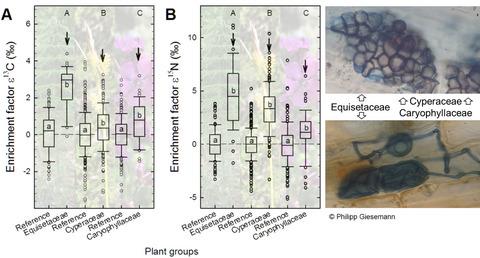当前位置:
X-MOL 学术
›
Funct. Ecol.
›
论文详情
Our official English website, www.x-mol.net, welcomes your
feedback! (Note: you will need to create a separate account there.)
Dark septate endophytes and arbuscular mycorrhizal fungi (Paris‐morphotype) affect the stable isotope composition of ‘classically’ non‐mycorrhizal plants
Functional Ecology ( IF 4.6 ) Pub Date : 2020-09-07 , DOI: 10.1111/1365-2435.13673 Philipp Giesemann 1 , David Eichenberg 1 , Marcus Stöckel 1 , Lukas F. Seifert 1 , Sofia I.F. Gomes 1, 2 , Vincent S.F.T. Merckx 2, 3 , Gerhard Gebauer 1
中文翻译:

深色的隔生内生菌和丛枝菌根真菌(巴黎形态型)影响“经典”非菌根植物的稳定同位素组成
更新日期:2020-09-07
Functional Ecology ( IF 4.6 ) Pub Date : 2020-09-07 , DOI: 10.1111/1365-2435.13673 Philipp Giesemann 1 , David Eichenberg 1 , Marcus Stöckel 1 , Lukas F. Seifert 1 , Sofia I.F. Gomes 1, 2 , Vincent S.F.T. Merckx 2, 3 , Gerhard Gebauer 1
Affiliation

|
- The vast majority of terrestrial plants exchange nutrients with fungal partners forming different mycorrhizal types. The minority of plants considered as non‐mycorrhizal, however, are not necessarily free of any fungi, but are frequently colonized by elusive fungal endophytes, such as dark septate endophytes (DSE) or fine root endophytes (FRE). While a functional role of FRE in the improvement of nutrient gain was recently elucidated, the function of DSE is still in discussion and was here addressed for 36 plant species belonging to the families Equisetaceae, Cypereaceae and Caryophyllaceae.
- Molecular and microscopic staining approaches were conducted to verify the presence of DSE in the investigated species. Stable isotope natural abundances of the elements carbon, nitrogen, hydrogen and oxygen and total nitrogen concentrations were analysed for the respective species of the target plant families and accompanying mycorrhizal and non‐mycorrhizal (Brassicaceae) plant species.
- Staining approaches confirmed the presence of DSE in all investigated species within the families Equisetaceae, Cyperaceae and Caryophyllaceae. A co‐colonization with Paris‐type arbuscular mycorrhiza (AM) was occasionally found by staining and molecular approaches in species of the Equisetaceae. Species of the Equisetaceae, Cyperaceae and Caryophyllaceae were significantly 15N‐enriched in comparison to accompanying plants. In addition, a significant 13C and 2H enrichment and increased total nitrogen concentrations were found for representatives of the Equisetaceae.
- The 15N enrichment found here for representatives of Equisetaceae, Cyperaceae and Caryophyllaceae provides evidence for a functional role of the ubiquitous DSE fungi. DSE fungi obviously provide access to 15N‐enriched soil organic compounds probably in exchange for organic carbon compounds from plant photosynthesis. As indicated by additional 13C and 2H enrichments, representatives of the Equisetaceae apparently gain simultaneously organic carbon compounds from their AM fungi of the Paris‐morphotype. Thus, species of the Equisetaceae have to be considered as partially, or in case of the achlorophyllous fertile Equisetum arvense, as fully mycoheterotrophic at least in some stages of their life cycle.
- So far, mostly underappreciated fungi classified as DSE are suggested to occupy an ecologically relevant role similar to mycorrhizae and the occurrence of simultaneous functions of DSE and AM fungi in Equisetaceae is proposed.
中文翻译:

深色的隔生内生菌和丛枝菌根真菌(巴黎形态型)影响“经典”非菌根植物的稳定同位素组成
- 绝大多数陆生植物与真菌伴侣交换养分,形成不同的菌根类型。但是,被认为是非菌根的少数植物不一定不含任何真菌,而是经常被难以捉摸的真菌内生菌(例如深色分隔内生菌(DSE)或细根内生菌(FRE))定居。虽然最近阐明了FRE在改善营养获得中的功能作用,但DSE的功能仍在讨论中,这里针对36种植物(马科,莎草科和石竹科)进行了探讨。
- 进行了分子和显微镜染色方法以验证所研究物种中DSE的存在。分析了目标植物科以及伴生菌根和非菌根(芸苔科)植物物种的碳,氮,氢和氧元素的稳定同位素自然丰度以及总氮浓度。
- 染色方法证实了马鞭草科,莎草科和石竹科中所有调查物种中都存在DSE。通过染色和分子方法在马科植物中偶尔发现了与巴黎型丛枝菌根(AM)的共定殖。与伴生植物相比,马科,莎草科和石竹科的物种富含15N。此外,发现木贼科的代表显着富集13 C和2 H并增加总氮浓度。
- 在这里发现的相当于马科,莎草科和石竹科的15 N富集提供了普遍存在的DSE真菌的功能性作用的证据。DSE真菌显然可以提供15种富含N的土壤有机化合物,可能以植物光合作用中的有机碳化合物为交换。正如其他13 C和2 H富集所表明的那样,木贼科的代表显然从其巴黎形态型AM真菌中同时获得了有机碳化合物。因此,木贼科的物种必须被认为是部分的,或者在叶绿素肥沃的木贼a的情况下,至少在其生命周期的某些阶段表现为完全异养。
- 到目前为止,列为大多怀才不遇真菌DSE是建议占据类似于菌根的生态相关的角色和同步功能发生DSE建议在木贼和AM真菌。











































 京公网安备 11010802027423号
京公网安备 11010802027423号